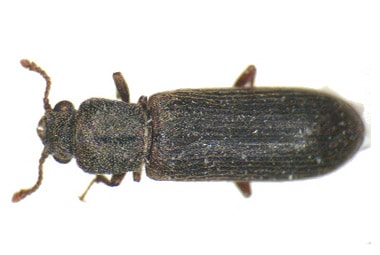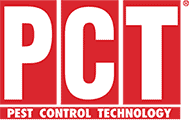
Powderpost beetles include several species of insects that tunnel into wood and reduce the wood into a fine powder. The two most common families to invade wood are the Lyctidae and the Anobiidae. Anobiid powderpost beetles attack older items that are made of both hard and soft wood, while lyctid powderpost beetles only infect products that are made from hard wood and are less than 5 years of age.
| Pest Identification | |
|---|---|
| Recognition | Adult anobiid powderpost beetles grow to be between 1/16 – ¼ of an inch in length and are reddish-brown to black in color. Their winged body is cylindrical and elongated in shape, and covered in fine hair. Anobiid powderpost beetles have a hood-like body segment that is located directly behind their head. This segment “covers” or “hides” their head. The larvae are slightly smaller than the adults and are whitish in color. The larvae are grub-like in appearance, C-shaped, have three pair of small legs, and rows of small spines on their dorsal side. |
| Biology | The entire life-cycle of the anobiid powderpost beetle can take up to 10 years to complete, but in most cases, the process takes 2-3 years. An adult female will lay her eggs (usually fewer than 50) under splinters, in cracks of wood, and in old exit holes. Once the larvae hatch they will feed on the wood surrounding them. It is the larval stage of the anobiid powderpost beetle that causes the damage and destruction. After the larvae feed and develop into adults they exit the wood by chewing their way out. During the exiting process, they will create 1/16 to 1/8 of an inch in diameter holes in the wood that they are infesting. After exiting the males and females will come together to mate, the females then look for a place to deposit their eggs. While she is more than capable of flying away and finding a new location to do this, she will most likely lay her eggs on the same piece of wood that she emerged from. |
| Habits | Anobiid powderpost beetles will infest both soft and hard woods and seem to prefer infesting structural elements of a home like beams, subflooring, posts, and plywood over other things. They prefer to invade older seasoned wood that has a moisture content above 14 percent and is located in dark cool areas of the home like basements and crawl spaces. |
| Damage | An important part of identifying anobiid powderpost beetles is to determine if the damage you are finding is from an active infestation or damage leftover from a previous infestation that has died out or was previously eliminated. If there is an active infestation in your home you will notice piles of “fresh” wood-colored powder gathering underneath exit holes. Exit holes from a previous inactive infestation will look weathered and any piles of powder will be dispersed or covered in debris. As a homeowner, you are more likely to see the damage from anobiid powderpost beetles than the beetles themselves. Mainly because the adults-only live for such a short period of time and are most active during the night. |
| Prevention | The best way to prevent a problem with anobiid powderpost beetles is to inspect older (antiques) items made of wood before bringing them into your home. If any signs of powderpost beetles are present then do not bring them into your home. Using old barn wood in your home should be limited and only installed after it has been treated for powderpost beetles by a professional pest control expert. |
| Professional | A Rottler pest management professional will be able to determine whether or not a powderpost beetle infestation exists and if the evidence indicates current or past activity. If beetles are active in your woodwork then our technician will work with you to determine which type of treatment, an aqueous borate treatment or chamber fumigation, should be used to treat your infestation. |

